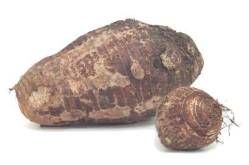|
|||||
|
|||||||
|
    An initiative of :Stichting Food-Info
|
| Food-Info.net> Food Products > Tropical roots and tubers CocoyamAgronomic CharacteristicsCocoyams are found as an important crop only in warm, humid forest areas because of their need for high annual rainfall and a long wet season. They thrive well on imperfectly drained soils and are not damaged by occasional flooding. Shady areas are not deleterious to cocoyam roduction, and they can be grown within the shade of other taller crops. The growth period is variable but lies close to that required for yams, about 7-10 months. 
Antinutritional FactorsThe high content of calcium oxalate crystals, about 780 mg per 100 g in some species of cocoyam, has been implicated in the acridity or irritation caused by cocoyam. Oxalate tends to precipitate calcium and makes it unavailable for use by the body. Oxalate has also been suspected to cause kidney stones. The acridity of high oxalate cultivars of cocoyam can be reduced by peeling, grating, soaking and fermenting during processing. Acridity can also be caused by proteolytic enzymes. Utilisation and ProcessingCocoyam is used in essentially the same way as yam. It can be eaten boiled, fried or pounded into fufu, although it is not considered as prestigious as yam. It can also be made into porridge or pottage, as well as chips and flour. Cocoyam flour has the added advantage that it is highly digestible and so is used for invalids and as an ingredient in baby foods. Taro (a variant of cocoyam) is the traditional staple in the Pacific Islands, where it is made into a series of food products similar to those described for cassava. Poi is a very popular Hawaiian and Polynesian dish made by pressure-cooking the raw tuber, which is then peeled and mashed to a semi-fluid consistency. It is passed through a series of strainers, the final one having openings of about 0.5 mm diameter. It is then bagged and sold, or else stored at room temperature where it undergoes lactic acid fermentation. Coconut products can be added to the fermented poi before consumption. In Nigeria, cocoyam is grated, mixed with condiments and wrapped in leaves. It is steamed for about 30 minutes and served with sauce. Popularly known as ikokore, it is very common in the western Nigeria. A modification is available in Cameroon where cocoyam is made into balls and cooked with additional ingredients. This is known as epankoko. |
|
| ||
| Food-Info.net is an initiative of Stichting Food-Info, The Netherlands | ||||||